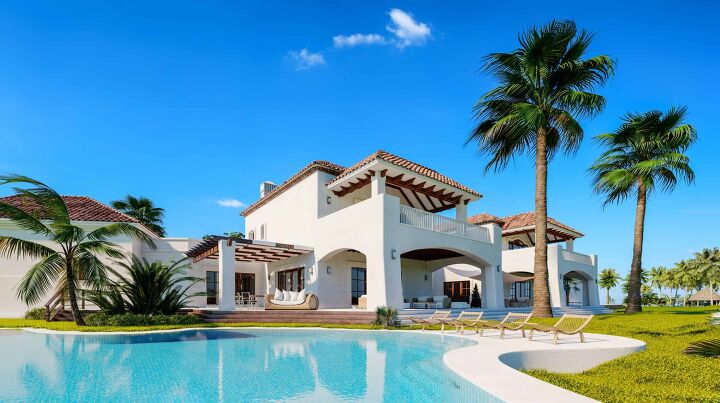What Makes A House A Mansion?

We’ve all seen houses that are so large, so impressive, that we consider them to be mansions. If they’re mass-made, you might even call them McMansions. But, what most people don’t realize is that there are specific guidelines that make a house a mansion. It’s not just about size, either. Ever wonder what the legit definition of a mansion is?
Mansions are defined by two main factors: square footage and luxury. Most definitions suggest that mansions start at 8,000 square feet of space as well as a minimum of five bedrooms. To be a mansion, you also have to have amenities that are uniquely luxurious in nature.
Do you ever wonder if those “McMansions” really live up to the “mansion” part of their monikers? If you take a closer look at the facts, the answer might be a little surprising…
Do You Need to Hire an Architect or a Builder?
Get free, zero-commitment quotes from pro contractors near you.

What is a Mansion?
It might be surprising to realize that houses are literally designated to be mansions, but it’s true. There are several different definitions that make a mansion an official mansion. All of the definitions, though, have similar guidelines. To give you a better idea of what makes a mansion legit, let’s take a look at each element, shall we?
How Big is a Mansion? (Square Footage)
Most realtors tend to term mansions as houses that have more than 8,000 square feet within their walls. However, the standards of what a mansion is can still vary from place to place. At the very least, you should expect to have a mansion’s square footage start at around 5,000 square feet. The maximum minimum square footage is around 10,000 square feet.
No matter how you look at it, it is safe to say that these houses are friggin’ huge.
How Many Bedrooms Are in a Mansion?
A large home is not enough for most real estate agents to define a house as a mansion. There’s also a minimum number of bedrooms expected of a mansion. However, there really is no hard and fast rule here. In the past, this would mean that a home would need 15 to 20 bedrooms before it’d be a mansion. These days, it’s not so stringent.
On average, most homes that are defined as mansions will have a minimum of five to six bedrooms. Any less, and it’s just a fairly large home. Some mansions may still have as many as 10 bedrooms. Though, even in homes that are more than 10,000 square feet, homeowners would rather pay more money for more amenities and larger bedrooms than more than 10 bedrooms.
What Luxury Amenities Do Mansions Have?
You can have a large house that’s not a mansion. The big divide between the two is luxury. A regular home will have regular amenities like a nice kitchen, a couple of bathrooms, and maybe a patio. When it comes to a mansion, things get a little more upscale. (And by a little bit, I mean a lotta bit.) These amenities below tend to be the most common mansion upgrades:
- Entertainment Rooms. If you have a ballroom, a party room, a cabana, or a large pool with a pool house, you probably are dealing with a mansion. Entertainment rooms are what make most people think of mansions, and remain a large portion of the appeal of a mansion.
- Leisure Space. When you’re on your own, you will probably need to find an area to cool down that’s not your entertainment area. This is where leisure space comes into play. A leisure space might be a home theater, a spa area, a sauna, or even something like an upscale man cave.
- Decadent Yards. You know you can always tell a mansion by the way their gardens and lawns look perfectly manicured. If you see a lot of sculpted trees, exotic flowers, and lush fountains, chances are that you are dealing with a real mansion rather than just a very nice house.
- Crazy Decorations. Mansions, if nothing else, are made to be a little bit over the top when it comes to their decorations. They might have custom lamps, molded statues, luxury stonework, and paneling made from exotic wood. The more “extra” a house is, the more likely it is that you are looking at a mansion.
- Unique Styles. This is one of the top reasons why McMansions are not deemed to be real mansions. They are mass-produced and tend to look alike. Since they are mostly manufactured, they can’t be regular mansions. A true mansion is usually a one-of-a-kind creation that had a specialty architect on board.
Types of Mansions
Though mansions are often placed under the same umbrella term, there are actually many different types of mansions. The main differences between each type mostly has to do with the design and structure. There are obviously a number of different sized mansions, but they are still all considered mansions.
McMansions
Typically, the most common type of mansion that most are aware of, McMansions are large, mass-produced, and usually found in suburban areas or new developments. The majority of McMansions were constructed after the 1970s and tend to lack character and design.
Unfortunately, the design of these types of mansions is an afterthought, as their main selling point is the size. While these homes are bad in any sense, they are just significantly different from Classical or Victorian style mansions. This mostly has to do with the fact that they use cheaper building materials and have unconventional detailing plans.
Victorian Style Mansions
Modeled after Victorian Europe, these types of mansions are elaborately detailed. Their distinctive style often features wrap-around decks, colorful paint jobs, jutting towers, and expansive gathering halls.
With their roofing designs, wooden appearance, and aged entranceways, Victorian style mansions also display a much older, timeless ambiance.
Classical Style Mansions
The easiest way to describe a classical style mansion is to imagine the homes from the Great Gatsby. These homes that thrived during the roaring twenties are complete with stunning, grand and winding staircases, towering ceilings, and sprawling hallways.
These mansions may even feature a ballroom, which was very common during this era. Classical style mansions were meticulously designed by an architect who paid attention to every minute detail – from the patio, landscaping, windows, and columns to the interior design, everything fits together effortlessly.
Colonial Style Mansions
Like classical style mansions, colonial style architects noticed every little detail. While the interiors may not be as grand, the design of these mansions is still elegant. Their design is generally wide and expansive, making their distinction as a mansion very apparent.
Colonial style mansions aren’t as popular throughout the United States and are much more common in some European countries, Latin America, and parts of South America.
Why Are Mansions So Different When Compared To Houses?
Mansions are not meant to be sold for the average, everyday Joe. They are meant to be a status symbol, a testament to a person’s success that will let people know they are something. That’s part of the reason why mansions are loaded with so many different amenities. As a result, they’re considered to be a luxury item.
Is The Definition Of A Mansion Rigid?
It is, and it isn’t. Most people agree that a mansion is going to be bigger and more luxurious than a typical home. That much is clear. In the real estate world, most agents will only consider a house a mansion over 8,000 square feet.
However, what individual buyers consider mansions will change from person to person. Some buyers won’t consider a 5,000 square foot house a mansion, even if it has a cabana and a view of the Hollywood sign. Others will. And yet, some will only start to think of mansions when they clock in at the 15,000 square foot mark.
Because of the personal preferences that are held with mansion buyers, it’s not a good idea to think of the definition as rigid. The definition of a mansion is highly variable.
Are McMansions An Equally Good Investment?
A mansion is generally seen as a great investment, but a McMansion isn’t. McMansions are often cheaply made, do not have the same amenities, and also carry a stigma due to their workmanship. Many homes of this type have been placed in areas that are prone to floods, surrounded by bad neighborhoods, or are just found in oversaturated markets.
If you want to get a McMansion, make sure that you get one in a good neighborhood and avoid ones that have been built in floodplains.
What’s the Difference Between a Mansion and an Estate?
An estate is usually a term used for inherited property, but can also be used to allude to a house that is larger than a mansion. Oftentimes, they are seen as one in the same for buyers. However, the biggest difference between a mansion and an estate is the extent of the land the home is built on.
Historically, estates are positioned on massive pieces of land, featuring farms, outbuildings, pastures, and potentially even towns or villages. Back then, the products that the farms on the estate produced would supported the main residence. Though, nowadays an estate simply refers to a large home that sits on acres upon acres of land.
While estates may still have farmland, the farms themselves aren’t usually enough to support the entire estate. Families who own estates in this day and age, have obtained their fortune elsewhere.
Do You Need to Hire an Architect or a Builder?
Get free, zero-commitment quotes from pro contractors near you.

Related Questions
Are McMansions always cheaply built?
The concept of a McMansion is one that is formulaic. A McMansion is meant to be large, but cheap. This means that most McMansions are designed to be cheaply built.
What size is a typical McMansion?
A typical McMansion will be between 3,000 to 5,000 square feet. So, it’s at the range right below the beginning size of a mansion. Unlike a true mansion, it will not have many luxury amenities included in its grounds, the design will be cookie-cutter, and the landscaping will be rather basic.

Ossiana Tepfenhart is an expert writer, focusing on interior design and general home tips. Writing is her life, and it's what she does best. Her interests include art and real estate investments.
More by Ossiana Tepfenhart



























